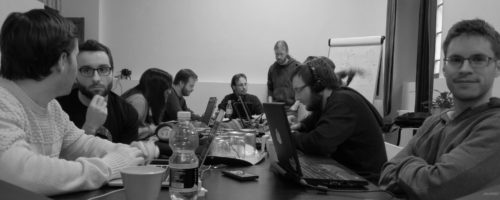I’m back from this year’s GStreamer hackfest, which was fantastic as usual — an intersection of great minds, big challenges, flaky Wi-Fi and good food. Christian already did a generic summary, so I’ll be narrating from the GNonLin/GES/PiTiVi perspective. See the end of this blog post for a nice video retrospective.

Edward provided an initial patch to improve the behavior of timestamps and seeking in GNonLin, while Nicolas “Stormer” Dufresne fixed two bugs causing deadlocks. Nicolas spent a lot of time discussing with Wim Taymans, Edward Hervey, Sebastian Dröge and other hackfesters about the architecture of GNonLin in light of GStreamer 1.x. He also fixed looping for the Ogg demuxer in pull mode and, with some help from Mathieu “Forest Ranger” Duponchelle, fleshed out the design for a new tree data structure for GNonLin.
Mathieu the Moustached Avenger worked on implementing keyframes in GES, paving the way for him to create a user interface to animate any effect property in PiTiVi. That user interface will most likely depend on him working on the clutter timeline canvas, so I’m looking forward to improvements in that area.
Thibault “Keyboard Crusher” Saunier finished the implementation of GES Containers and clip groups, then worked on implementing — at long last — audio mixing in GES. This is an essential feature of multitrack audio/video editing, and I’m really happy to see that feature make its comeback for the next release of PiTiVi. This work will also depend on Mathieu’s keyframes UI. A proper reimplementation of video mixing remains to be done, however.
There are lots of outstanding things to solve in GNonLin and GES. Nicolas has a bunch of ideas for things to improve and redesign in GNonLin and I expect much collaboration between Thibault and him to optimize the entire stack for better reliability and performance (for example, adding caps filters to allow realtime downscaling of videos to improve preview performance, configurable downstream buffering for playback to avoid frame drops in CPU-intensive parts of a timeline, etc.). GNonLin and GES have much potential to allow us to be a lot smarter than before.
Personally, I spent most of my time testing, discussing and hacking on some new features for PiTiVi.
- I added a button in the timeline toolbar that toggles the “gapless mode” (automatic ripple edits), which makes your clips behave like magnets and prevents needing to re-arrange them manually all the time. The feature works and will be merged after a customary code review.
- I made some progress on the custom effects UI branch. Once it’s complete, you will be able to easily create custom user interfaces for effects that require it, simply by using a glade/gtkbuilder .ui file (or, if you prefer, a set of widgets from your own python module). Of course, for the majority of effects, our automatically generated user interfaces are still good enough, so we can keep using them and avoid unnecessary work.
(See my previous blog post for a situation report on where we stood with PiTiVi before the hackfest)
I also spent a bit of time setting up my film making gear and shooting various interesting moments of the hackfest. Here’s my montage, which will tell the story much better than a long blog post. Hope you’ll like it:
I would like to thank Collabora for allowing many GStreamer contributors to attend the hackfest, which I consider vital to the health of the GStreamer community. I was happy to meet again with many friends and help push the Free multimedia stack forward. Props to Christian Schaller and Alessandro Decina for organizing the whole thing, too!
Aside from Collabora and Fluendo sponsoring two of our dinners (thanks!), I would also like to thank you, PiTiVi supporters, for making it possible for me to spend some money to thank GStreamer contributors with some food and beer — maximum boost to the GStreamer community! Full disclosure: I used 84 euros worth of PiTiVi donations for that purpose.
Comments
One response to “GStreamer Hackfest 2013: Moving Images”
Just popping in to say I really liked the video. One thing people who have never been to a hackfest don’t quite get is the feel of the thing, especially how people float between looking at their keyboards and looking at each other. This helps. 🙂